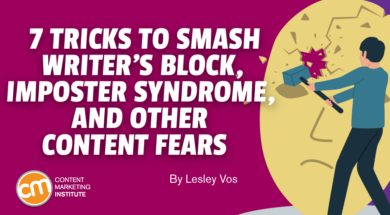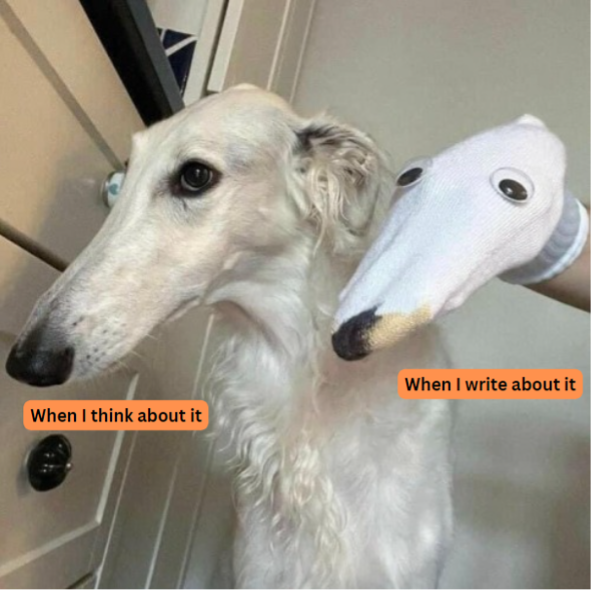 Yes, writing is hard.
Yes, writing is hard.
When writing for content marketing, the process becomes even more challenging. You have no time to sit and wait for inspiration or the muse to help you craft engaging text. You have content plans to follow and deadlines to meet.
That’s when fear arises.
Raise your hand if one of these whispers creeps into your mind when you try to write:
- “A better article exists already. My content is a pathetic copy.”
- “I’m not good enough. I can’t write better than [your guru’s name here].”
- “So much info! Can I structure all of it? I’ll miss something essential.”
- “What should I write?”
- “They won’t like it. I’ll get rejected.”
- “My draft sucks; it’s boring.”
- “Johnny writes 1,000 words every day. I’m too slow.”
Writing fears fall into two categories: doubts about your abilities or concern over others’ judgment of your work. You can tame blank-page syndrome, imposter syndrome, writer’s block, or whatever stops you from creating great content with these seven simple yet effective tricks.
Writing fears fall into two categories – doubts about your abilities and concern over others’ judgment of your work, says @LesleyVos via @CMIContent. #ContentMarketing Click To Tweet
1. Practice therapeutic writing
Therapeutic writing will help prevent blank-page syndrome – staring at the screen with no idea how to start a content piece. Some blame this on a lack of inspiration, while others use grimmer diagnoses like emotional burnout or even workplace depression. Skeptics are less euphemistic, calling it nothing but the fear of writing crap.
To beat it, develop a daily writing habit. You may have heard about Morning Pages – a system that has you write (in long hand) three pages of stream-of-consciousness text first thing in the morning. Following free-writing practices and keeping a diary also fall into this category. If these exercises work for you, great. If not, you can try therapeutic writing.
Keep a journal where you regularly write a letter to a chosen addressee, telling them about daily events that made you angry, sad, anxious, or happy. You may publish these as short sketches on social media.
In the post below, the author at handle @heyamberrae pens a letter to her followers about “experiencing the most extraordinary love” she’s ever known.
How can therapeutic writing help with professional content writing?
Practicing such reflective writing makes you less likely to freeze at that intimidating text cursor. You’ll beat the fear of an imperfect draft and use the “write-first, edit-later” rule we all know (but often forget).
2. Start a ‘clever-thoughts’ notebook
A notebook with clever thoughts is not a collection of quotes from writing gurus and influences, though that could be an inspiring practice.
A clever-thoughts notebook contains the ideas, sentences, and interesting facts you learn during the day from books, websites, etc. An average person has around 6,000 thoughts daily but forgets most by evening, so the notebook will help you remember your best ones. And that list will come in handy next time you need to write text but worry you have nothing to say.
Jot down your clever thoughts in a notebook. They may come in handy the next time you struggle to come up with content ideas says @LesleyVos via @CMIContent. Click To Tweet
3. Record your voice
Сreative content ideas, topics, and arguments may come to you when you’re nowhere near your laptop or a notebook. Haven’t we all had a brilliant idea caught in the dead of night, only to forget everything by morning?
Other times your thoughts flow freely – until you try to write them down. When you sit down to summon the right words, you forget what you wanted to say.
It’s like this meme, which I tweaked for content writing: You envisioned a real-life dog, but your writing only produces the socket puppet version.

To avoid writer’s block and still get your idea down, record your thoughts when they come to you. Then transcribe the recording or use the voice-typing feature in your writing app. You’ll be able to structure your dictated thoughts into content assets later.
4. Opine on opinions
This trick can help you beat the you’re-not-good-enough writing fear.
After reading an influencer’s thoughts and insights on a topic, think of supporting arguments or counterarguments. Then, write them down as if you were having a dialogue with that person.
The tactic helps you think critically, develop arguments, structure the facts, and manage your information priorities. It serves you in crafting more comprehensive content, whether you write about restaurants, create cause-related posts, or practice guest blogging to reach content marketing goals.
Writing trick: Read a respected person’s thoughts on a topic and write a counterargument, says @LesleyVos via @CMIContent. #ContentMarketing Click To Tweet
5. Mirror your favorite writer
It stands to reason that content creators read a lot. As my favorite author, Stephen King, says, “If you don’t have time to read, you don’t have the time (or the tools) to write. Simple as that.”
And, as my second yet no less favorite writer Ernest Hemingway said, “There’s no friend as loyal as a book.” Not only can these loyal friends make your content better, but they can help smash the fear of rejection and not being good enough to write.
(Confession: I had both those fears before pitching my first article to the Content Marketing Institute.)
Who is your favorite writer, essayist, or blogger? Do you analyze their writing style while reading? Do you notice language tricks they use?
Mirroring a writer is among the most efficient techniques for developing a writing style. It helps enhance your vocabulary, add a few alternative writing tactics to your content creation toolkit, and conquer your fear of criticism.
(Confession: Once I learned that Stephen King got 30 rejections before his book Carrie was published, there was no room left for the “not good enough” fear.)
6. Read the news and niche resources
The daily habit of reading the news and niche blogs brings benefits for content writers. These include:
- Better cognitive skills and brain functioning
- Enriched vocabulary
- New ideas for content creation
- Writing style inspiration
But please note: This trick won’t work if you read everyone and everything. Make a list of professional resources that inspire and educate you at the same time.
(Confession: I learned the art of web writing from Ann Handley and Jon Morrow. And Henneke Duistermaat’s works help me feel the beauty of English and make peace with my inner critic. Plus, her list of writing fears inspired me to create this article.)
This tweet from Henneke describes how she used to think of herself as a writing wimp and pondered why she couldn’t be as confident as others. But she discovered that writing fears are normal – the fear signals that you’re out of your comfort zone and writing something that matters.
I used to think I was a writing wimp.
Why couldn’t I be as confident as everyone else?
But I’ve discovered: Writing fears are normal.
Fears are sign you’re out of your comfort zone & you’re writing something that matters.
So, dance with your fears >>> https://t.co/PLoSQw2bei pic.twitter.com/Y4jpu72Wld
— Henneke Duistermaat (@HennekeD) November 3, 2022
Who is on your list of resources to follow?
7. Stay in a professional space
A great practice to smash fears and self-doubts for content writers is to stay in the professional space. Attend seminars, participate in conferences or webinars, visit local meetings, communicate with interesting people on social media, etc. These interactions can prevent you from hitting a plateau and enhance writing productivity.
Social participation can trigger happy chemicals in the brain to satisfy the need for excitement. This excitement acts as an inspiration to write more and “forget” the imposter syndrome and other writing fears for a while.
Ready to say goodbye to your writing fears?
Fears (of a blank page, failure, rejection, writing crap, or not being good enough) act like little beasts, gnawing at your writing ego and preventing you from enjoying the content creation process.
Once you name your beast, you can arm yourself with one or more of these tricks to help you smash them.
HANDPICKED RELATED CONTENT:
Cover image by Joseph Kalinowski/Content Marketing Institute